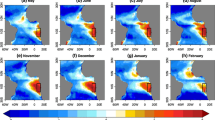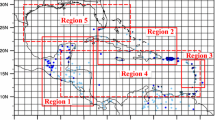Abstract
We examine the internal climate variability of a 1000 year long integration of the third version of the Hadley Centre coupled model (HadCM3). The model requires no flux adjustment, needs no spin up procedure prior to coupling and has a stable climate in the global mean. The principal aims are (1) to validate the internal climate variability against observed climate variability, (2) to examine the model for any periodic modes of variability, (3) to use the model estimate of internal climate variability to asses the probability of occurrence of observed trends in climate variables, and (4) to compare HadCM3 with the previous version of the Hadley Centre model, HadCM2. The magnitude and frequency characteristics of the variability of the global mean surface temperature of HadCM3 on annual to decadal time scales is in good agreement with the observations. Observed upward trends in temperature over the last 20 years and longer are inconsistent with the internal variability of the model. The simulated spatial pattern of surface temperature variability is qualitatively similar to that observed, although there is an overestimation of the land temperature variability and regional errors in ocean temperature variability. The model simulates an El Niño Southern Oscillation with an irregular 3–4 year cycle, and with a teleconnection pattern which is much more like the observations than was found in HadCM2. The interdecadal variability of the model ocean in the tropical Pacific, North Pacific and North Atlantic is broadly similar to that in the real world with none of the simulated patterns having any periodic behaviour. HadCM3 simulates an Arctic Oscillation/North Atlantic Oscillation (NAO) in Northern Hemisphere winter which has a spatial pattern consistent with the observations in the Atlantic region, but has too much teleconnection with the North Pacific. The recent observed upward trend in the NAO index is inconsistent with the model internal variability. The variability of the simulated zonal mean atmospheric temperature shows some marked differences to the observed zonal mean temperature variability, although the comparison is confounded by the sparse observational network and its possible contamination by a climate change signal.
Similar content being viewed by others
Author information
Authors and Affiliations
Additional information
Received: 24 August 1999 / Accepted: 28 April 2000
Rights and permissions
About this article
Cite this article
Collins, M., Tett, S. & Cooper, C. The internal climate variability of HadCM3, a version of the Hadley Centre coupled model without flux adjustments. Climate Dynamics 17, 61–81 (2001). https://doi.org/10.1007/s003820000094
Issue Date:
DOI: https://doi.org/10.1007/s003820000094




